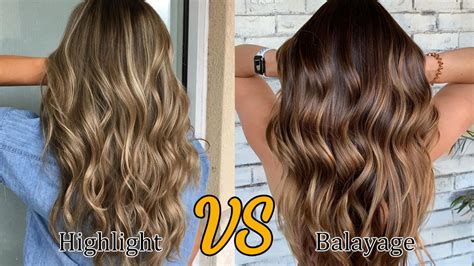When it comes to hair coloring, two popular techniques that often pop up are balayage and highlights. While both techniques aim to add depth and dimension to your hair, they differ in several key aspects. Understanding these differences can help you determine which technique is right for you.

1. Application Method: Precision vs. Freehand
Balayage: This freehand technique involves painting color onto the hair using a brush. The colorist strategically places the color, creating subtle, sun-kissed effects. The paint-on application allows for precise placement and a more natural-looking blend.
Highlights: In contrast, highlights use a more traditional foiling technique. Hair strands are woven through a cap or foils, and color is applied to the exposed strands. This method provides more control over the placement of color, but it can yield more obvious, chunkier highlights.
2. Color Distribution: Sun-Kissed vs. Bold Contrast
Balayage: Balayage creates a seamless, graduated effect. The color is concentrated towards the ends of the hair, mimicking the natural way hair lightens in the sun. This results in a more subtle, low-maintenance look.
Highlights: Highlights offer bolder, more contrasting results. The color is evenly distributed throughout the hair, creating a more noticeable and defined effect. Highlights can be customized to achieve a range of looks, from subtle to vibrant.
3. Maintenance: Time and Effort
Balayage: Balayage requires less maintenance compared to highlights. The subtle, natural blend means that root touch-ups are less noticeable and can be spaced out further apart, typically every 4-6 months.
Highlights: Highlights, on the other hand, require more frequent maintenance. As the color fades from the root, a sharp line of demarcation becomes evident. Regular touch-ups, usually every 8-12 weeks, are necessary to maintain the desired look.
4. Price Range: Investment and Value
Balayage: Balayage is generally more expensive than highlights, ranging from $150 to $300 per session. The cost varies depending on factors such as hair length, colorist skill, and salon location.
Highlights: Highlights are typically priced between $100 to $200 per session. While they may initially be cheaper, the higher maintenance costs associated with highlights can make balayage a more cost-effective option in the long run.
5. Trendy Appeal and Versatility
Balayage: Balayage has gained immense popularity in recent years due to its natural-looking results. It complements a wide range of hair colors and styles, from blonde to brunette and even red.
Highlights: While highlights remain a classic choice, they have become less trendy in recent times. However, they still offer versatility and can create a variety of looks, from subtle to dramatic.
Additional Considerations
Consultation: Before committing to either technique, schedule a consultation with an experienced hair stylist. They can assess your hair type and desired results to determine the best approach for you.
Hair Health: Both balayage and highlights involve the use of chemicals. It’s important to have healthy hair before undergoing any coloring process. Damaged or processed hair may not tolerate color well.
Home Maintenance: To maintain the vibrancy of your hair color, invest in quality hair care products. Use color-protecting shampoos and conditioners, and limit heat styling to prevent fading.
FAQs
1. Which technique is better for natural-looking results?
Balayage is the preferred choice for a more subtle, sun-kissed look.
2. How often should I refresh my color?
Balayage requires less maintenance than highlights, with touch-ups recommended every 4-6 months. Highlights may need touch-ups every 8-12 weeks.
3. Can I do balayage or highlights at home?
It’s not recommended to attempt balayage or highlights at home. These techniques require professional skill and precision to achieve optimal results.
4. Which technique is less damaging to hair?
Both balayage and highlights involve chemical processing, but balayage is generally considered less damaging. The freehand painting technique allows for more targeted application, minimizing the amount of hair exposed to chemicals.
5. Is balayage suitable for all hair types?
Balayage is versatile and complements all hair types, including thick, thin, straight, and curly hair.
6. What’s the difference between ombré and balayage?
Ombré involves a gradual blend of two or more shades of color from roots to ends. Balayage, on the other hand, uses a more subtle, freehand painting technique to create a sun-kissed look.
Tables
Table 1: Application and Maintenance Comparison
| Technique | Application Method | Maintenance |
|---|---|---|
| Balayage | Freehand painting | Less maintenance (touch-ups every 4-6 months) |
| Highlights | Foiling | Higher maintenance (touch-ups every 8-12 weeks) |
Table 2: Cost Comparison
| Technique | Price Range |
|---|---|
| Balayage | $150-$300 |
| Highlights | $100-$200 |
Table 3: Benefits of Balayage
| Benefit | Description |
|---|---|
| Natural-looking results | Seamless, sun-kissed effect |
| Lower maintenance | Less frequent touch-ups required |
| Less damaging | Targeted application minimizes chemical exposure |
Table 4: Benefits of Highlights
| Benefit | Description |
|---|---|
| Customizable contrast | Precise placement allows for a range of looks |
| More defined effect | Noticeable color transformation |
| Adds depth and dimension | Creates a bolder, more vibrant look |
